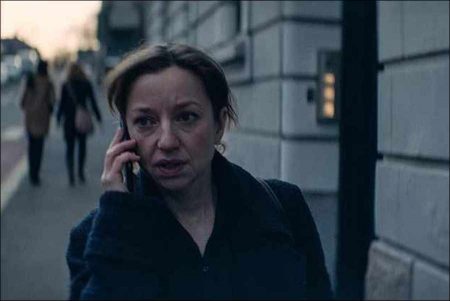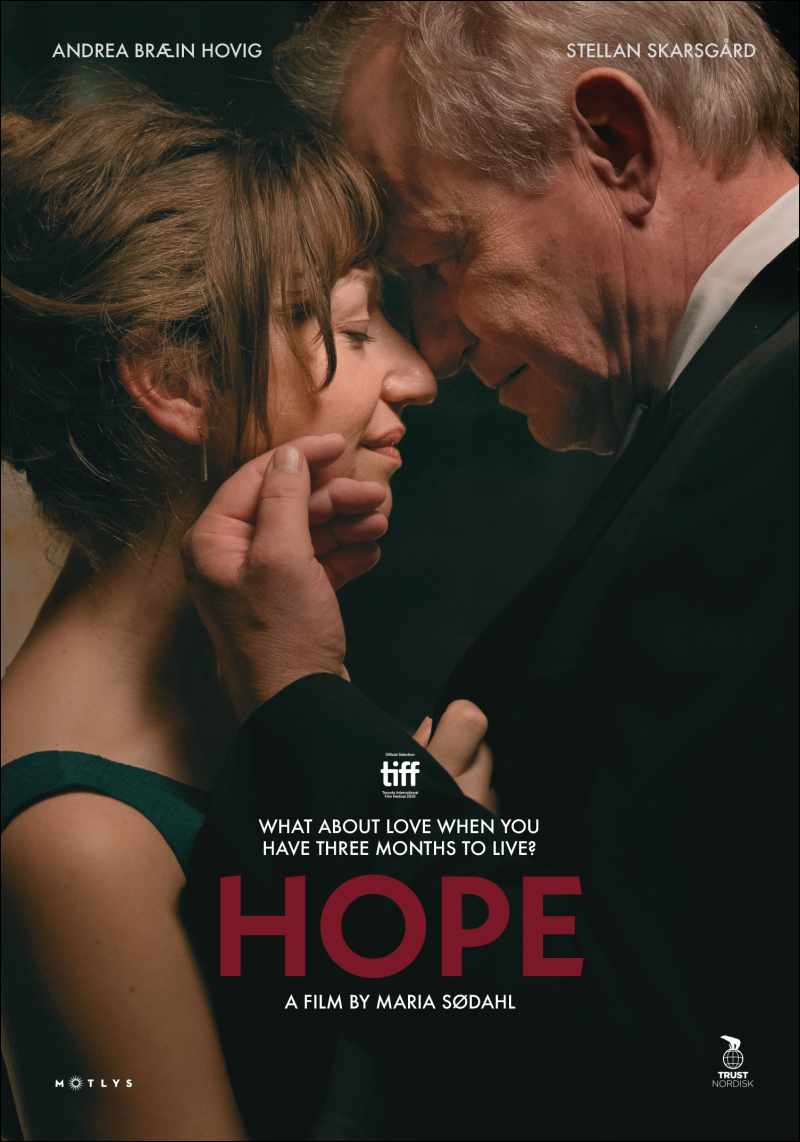Hope movie storyline. Anja (Andrea Bræin Hovig) and Tomas (Stellan Skarsgård), the principals in Maria Sødahl’s moving Hope, adore their careers in dance and theatre. Their blended family structure is complicated, with two young sons and an adolescent daughter from their own union and two adult children from Tomas’ marriage. Returning home after the triumphant international debut of a ballet she directed, Anja finds Tomas is working late, a galling abnegation of responsibility in her eyes.
Then her physician gives her a dire diagnosis: she has an inoperable tumor that may be connected to the lung cancer for which she was successfully treated the previous year. A long-time superwoman who’s been compensating for an often absent, workaholic husband, Anja soldiers on, refusing to tell anyone but Tomas what’s happening – and becoming increasingly exasperated by her children’s blissful ignorance, while only intermittently buoyed by Tomas’ support. The next few days will test the strength of their relationship more than any other challenge they’ve faced.
Hope (Norwegian: Håp) is a 2019 Norwegian semi-autobiographical drama film directed by Maria Sødahl, based on the experience she faced with her husband, director Hans Petter Moland, when, nine years earlier, she had received a terminal diagnosis of brain cancer and was given by doctors only three months to live.
The film was selected as the Norwegian entry for the Best International Feature Film at the 93rd Academy Awards, making the shortlist of fifteen films. The film premiered at the 44th Toronto International Film Festival on September 7, 2019 and was first theatrically released in Norway on November 22, 2019. Hope grossed $0 in the United States and Canada, and a worldwide total of $2.7 million.
Film Review for Hope
Believe the accolades: Maria Sødahl’s perceptive, heartfelt “Hope” richly deserves all the attention it’s gotten at festivals and award ceremonies since premiering in Toronto in 2019. Naturally, any movie with such a title dealing with a terminal cancer diagnosis will have some kind of sting, but “Limbo” director Sødahl, who mined her own brush with cancer when writing the film, teases out the unexpected byways where hope is not just crushed but nurtured. It’s hard, especially now, to want to expose oneself to a drama in which illness is the catalyst, but the rewards here are great, not just for the multi-layered screenplay but the impeccable performances by Andrea Bræin Hovig and Stellan Skarsgård. As Norway’s Oscar submission, “Hope” prompts high expectations.
Boosting attention will be the announcement that Nicole Kidman is executive producing a television series with her Blossom Films company based on the feature (rights had been purchased by Amazon Studios), with the star in the lead role. Given the plot’s extended family dynamics, there’s certainly material enough to spin into a multi-chapter series, though the movie’s tightness and intimacy are part of the reason the viewer is completely involved.
We notice every time a character touches another, equally feeling that touch, just as it hits us whenever a character is isolated and denied physical comfort when most needed. Sødahl’s skill at making gesture and its absence count in the most subtle ways is an essential component in our investment with these protagonists, thanks to the superbly understated camerawork of Lars von Trier’s regular DP Manuel Alberto Claro.
ZDF Studios and BlackBox Multimedia Partner to Produce Romantic Comedy Drama ‘The Little Italian Hotel’ (EXCLUSIVE)
Anja (Andrea Bræin Hovig) returns home to Oslo following the success of her first dance production abroad, but while her work is finally getting international recognition, the situation with her older, more established theater director partner Tomas (Stellan Skarsgård) has atrophied.
From the outside, everything is perfect: They have a large, luminous apartment, and their three children, ages 10 to 16, are tight with Tomas’ three children from his earlier marriage. Yet the couple are in a rut. She’s annoyed by his full-time focus on work, while he’s withdrawn into his own world, apparently content with the status quo but unable to recognize her emotional needs.
Headaches and dizziness prompt a doctor’s visit the day before Christmas Eve; tests show she has a massive edema and tumor in her brain, possibly metastasized from a lung tumor she thought had been successfully treated a year earlier. As Anja sits in shock, Tomas curves into himself and weeps. She’ll need to take large quantities of steroids to get the edema down before they can operate, though this type of cancer is incurable and until more tests are done, it’s unknown whether surgery will prolong her life. One year earlier, Christmas for the family was ruined because of her illness, so Anja resists spoiling the holidays now by telling the kids. Keeping herself together, with the headaches, nausea, irritability and bouts of energy from the steroids, won’t be easy.
What follows is delineated day by day as she struggles to remain stable while taking stock of her relationship, with everything intensified by the holidays and the medication. Anja goes through a whirlwind of emotions — anger, despair, exhaustion — which Tomas tries to keep up with, but he’s unused to expressing his fears and desires, which means the couple emotionally isolate themselves exactly when they need each other most. There’s a brilliant scene on Christmas, when she turns to him in bed with tenderness, her caress shifting into gentle lovemaking which quickly turns violent as she rages on top of him, letting out all her fury in a frightening trajectory symbolic of her desperation for him to open up and his sense of helplessness as he faces her imminent death.
The evening before, her father Martin (Einar Økland) tells her he wishes she and Tomas were happier together. “I guess we’re as happy as we deserve to be,” she replies, the line becoming an inescapable, haunting summation of how their lives as a couple had stalled. In the roller-coaster days that follow, Anja reflects on the relationship and questions her life choices, inching toward an understanding of just how much Tomas loves her, and how, together, they’ll be able to face whatever lies ahead.
Mixed in are the children and how they process the news, their personalities very well-delineated. Sødahl also incorporates doctors with varying bedside manners plus friends of the couple, all grasping for comforting things to say. Sødahl’s intimate familiarity with multiple elements of the story make her extra-sensitive to the diverse points of view of everyone involved, enriching the drama and grounding it in a reality that transcends the kind of easy heart-tugs one might expect, especially given that it all takes place during the holidays. Refreshingly, she integrates the family both within the bonds of kinship and in the broader world, so we feel their lives before and can imagine them after.
Every actor, including the youngest, is worthy of praise, but it’s Hovig and Skarsgård who command of our attention. Hers is the more demonstrative role, barreling forward on a steroid high with periodic collapses, the tension in her entire body wound like a strained rubber-band. Tomas at first is the much less sympathetic character, seemingly neither hot nor cold, but Skarsgård is a wonder at conveying his bereft core with just minimal body language and eye movements, as if his insides have been chipped away. As viewers we’re painfully aware of the physical voids between them (there’s also a devastating moment after Anja tells the kids and they all comfort each other without realizing they’ve left her standing alone), yet the emotional spaces are just as fraught, and watching these two find their way back to each other is a significant part of the film’s poignancy.
Claro’s assured use of widescreen heightens the perception of separation, the family’s large apartment allowing for isolation as well as space for crowded gatherings. The camera is neither intrusive nor coldly distant, allowing us to feel even more engaged, and it beautifully captures the special softness of Scandinavian early winter light. Also to be commended is Jørgen Stangebye Larsen’s production design, as well as Sødahl’s gratifying use of Vivaldi’s richly expressive “Vedrò con mio diletto.”
Hope (2019)
Håp
Directed by: Maria Sødahl
Starring: Andrea Bræin Hovig, Stellan Skarsgård, Elli Rhiannon Müller Osborne, Alfred Vatne, Eirik Hallert, Steinar Klouman Hallert, Dina Enoksen Elvehaug, Kristin Voss Hestvold
Screenplay by: Maria Sødahl
Production Design by: Jørgen Stangebye Larsen
Cinematography by: Manuel Alberto Claro
Film Editing by: Christian Siebenherz
Costume Design by: Ellen Dæhli Ystehede
Set Decoration by: Kaja Raastad
Art Direction by: Hailey Reynolds Hall, Simen Hauge Paulsen
MPAA Rating: None.
Distributed by: Kimstim Films (United States)
Release Date: September 7, 2019 (TIFF), November 22, 2019 (Norway)
Views: 27










